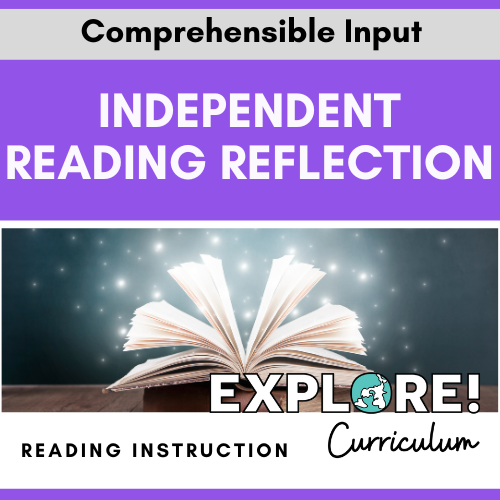6 Tips to Help World Language Students Read Independently
Well-implemented independent reading is low-prep, high-impact, and 100% individualized.
Since high school, I’ve collected French-language books and magazines as I’ve traveled. For much of my teaching career, my voluminous library was on display in my classroom. I always directed fast finishers to select a book to look at, and the colorful display surely impressed any administrator who stepped into my room. Having lots of realia is good practice, right? I was proud of my little library. Still, a few things bothered me:
Many students never opened any of my books. I was reaching the top students with my authentic resources, but no one else.
Even the top kids seemed not to know what to do with the books they picked up. They aimlessly flipped pages. Was any learning taking place?
There was no accountability or assessment for the students who read independently. Should there be? Doesn’t that distract from the joy of reading?
I noticed that as my collection aged, kids took less and less interest in the library. Even books that I considered ‘high interest’ (like comic books) were becoming less likely to capture kids’ attention.
My first step in addressing these concerns was to totally revamp my classroom library with more engaging reading matter. You can read about that process in last week’s blog, and check out this list of great classroom library books for French teachers.
With an engaging, age and proficiency-level appropriate library in place, I was ready to incorporate independent reading into my lesson plans. Over time, I discovered 6 practices that helped my students read successfully, along with a few ideas for assessing this rather subjective skill.
Practices to Support Independent Reading
“It’s important for kids to realize they don’t have to understand everything to be successful readers. During in-class independent reading, the goal is to figure out something new and to move forward as a language learner”
1. Teach Reading Strategies
When you encounter a challenging text in the target language, what do you do? As expert readers, we teachers have a variety of reading strategies to pull from. For example, we:
reread
look for known information
ask questions about the text
make inferences
connect to our knowledge of the world
tolerate ambiguity
identify specific areas of confusion
maybe – maybe look up one or two key words, after we’ve spent time with the text and identified where we need help.
We use all of these strategies without really realizing it! Struggling readers in our class, on the other hand, may read the text once from beginning to end and then say, “I don’t get it!” Or, they may turn immediately to an online translator to do the work for them.
As we incorporate independent reading in class, take time to intentionally teach reading strategies and to help kids become aware of strategies as they read. For a more in-depth look at how to teach reading strategies, check out my blog posts on What Makes a Good - or a Struggling - World Language Reader and many other blog posts about reading instruction.
2. Give students choice
On independent reading days, I like to spread a variety of appropriate books around the classroom and let students choose any book they want. Also, students don’t necessarily have to read the entire book. Maybe a page or two is sufficient to accomplish the task I assign. That leads to the next tip;
3. Provide an achievable task
It’s important for kids to realize they don’t have to understand everything to be successful readers. During in-class independent reading, the goal is to figure out something new and to move forward as a language learner. This may mean only mastering one page, or discovering some new vocabulary for a specialized topic, or working through the same text over several classes. My main goals for students are to:
figure out main ideas
understand some new vocabulary
articulate awareness of strategies they are using to reader
tolerate ambiguity and be comfortable asking questions
On independent reading days, I provide this worksheet for students to record their thinking. I like how it’s focused on achieving a task, while providing flexibility to work with different text lengths, topics, and difficulty levels. You’re welcome to copy it and make it yours.
4. Allow time with an online translator… at the end of the reading session.
As a language learner myself, there are times I use a translator or look up a word. Students also need practice and permission to use these tools. After 15-20 minutes working with a text, and after students have identified specific questions about the vocabulary in a text, consider allowing them to look up a few words. This practice strikes a nice balance between pushing students to use reading strategies, answering their questions, and teaching them use translators productively.
5. Model your own reading process.
While students are reading, I read a French text from the classroom library as well! Then, I project the text I read and perform a ‘think aloud’, modeling my own thinking process as if I was a student at their language proficiency level. I verbally demonstrate how I express confusion, identify questions, form theories, work back and forth through the text, and build comprehension. Sometimes there’s a word I can’t figure out… that’s the one I look up in the dictionary. Modeling this process frequently is helpful to emergent readers in our classes and sends the message that language learning is a lifelong process.
6. Invite students to share their learning
After reading, I like giving students the opportunity to show a partner what they read and share how they figured out unclear texts. Sometimes I invite individuals to share their learning with the class. Successful reading is intrinsically satisfying, and students are usually proud of what they figured out and eager to share. This is also great publicity – often students want to read a book recommended by a classmate during our next independent reading time!
Well-implemented independent reading is low-prep, high-impact, and 100% individualized. It’s become one of my students’ favorite classroom routines. It even makes a great sub plan, once the procedure is established.
The final component of well-designed independent reading instruction is the assessment. This piece is a little tricky and deserves its own blog post. So, stay tuned! In the mean time, reflect on your own target language reading practices and your classroom reading instruction. Which of the points above resonate with you? Are there other components of reading instruction we should add in our classrooms? Share in the comments!




